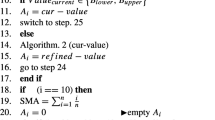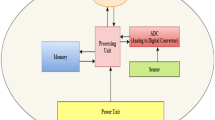Abstract
An effective way to conserve energy in wireless sensor networks is reducing the amount of data transmissions. However, this can affect the accuracy and reliability of the sensed data considerably. To provide energy-accuracy trade-off, data fusion technique can be applied exploiting temporal and spatial correlation of sensed data. In this paper, we propose a novel approach for balancing energy consumption and measurement accuracy in wireless sensor networks. The approach is a combination of accuracy enhancement algorithm SensAcc and active node selection algorithm ActiveNode, which are based on the robust interval fusion with preference aggregation (IF&PA) method. The approach is aimed at selecting minimum number of nodes that can provide data of sufficient volume and quality to maintain required accuracy. The performance of the proposed algorithms has been evaluated by both simulation and real data processing. Simulation results show that the proposed approach significantly enhances the network lifetime while providing highly accurate measurement outcomes. Results of real data processing demonstrate noticeable decrease of measurement uncertainty even for small number of sensor nodes.








Similar content being viewed by others
References
Akyildiz, I., Su, W., Sankarasubramaniam, Y., & Cayirci, Y. E. (2002). Wireless sensor networks: A survey. Computer Networks, 38(4), 393–422.
Yick, J., Mukherjee, B., & Ghosal, D. (2008). Wireless sensor network survey. Computer Networks, 52(12), 2292–2330.
Oliveira, L. M. L., & Rodrigues, J. J. P. C. (2011). Wireless sensor networks: A survey on environmental monitoring. Journal of Communications, 6(2), 143–155.
Alemdar, H., & Ersoy, C. (2010). Wireless sensor networks for healthcare: A survey. Computer Networks, 54(15), 2688–2710.
Dubois, D., & Prade, H. (2001). Possibility Theory in Information Fusion. In G. Della Riccia, H.-J. Lenz, & R. Kruse (Eds.), Data fusion and perception. Berlin: Springer.
De Farias, C. M., Pirmez, L., Fortino, G., & Guerrieri, A. (2019). A multi-sensor data fusion technique using data correlations among multiple applications. Future Generation Computer Systems, 92, 109–118.
Verma, N., & Singh, D. (2018). Data redundancy implications in wireless sensor networks. Procedia Computer Science, 132, 1210–1217.
Chen, Y., Shu, J., Zhang, S., Liu, L., Sun, L. (2009). Data fusion in wireless sensor networks. In Proceedings of the 2nd International Symposium on Electronic Commerce and Security, (vol. 2, pp. 504–509).
Muravyov, S. V., Tao, S., Chan, M. C., & Tarakanov, E. V. (2015). Consensus rankings in prioritized converge-cast scheme for wireless sensor network. Ad Hoc Networks, 24(1), 160–171.
Shobana, M., Sabitha, R., Karthik, S. (2020). Cluster-based systematic data aggregation model (CSDAM) for real-time data processing in large-scale WSN. Wireless Personal Communications.
Ayadi, A., Ghorbel, O., Obeid, A. M., & Abid, M. (2017). Outlier detection approaches for wireless sensor networks: A survey. Computer Networks, 129(Part 1), 319–333.
Gil, P., Martins, H., & Januário, F. (2018). Outliers detection methods in wireless sensor networks. Artificial Intelligence Review, 52(4), 2411–2436.
Boulis, A., Ganeriwal, S., & Srivastava, M. B. (2003). Aggregation in sensor networks: An energy–accuracy trade-off. Ad Hoc Networks, 1, 317–331.
Villas, L. A., Boukerche, A., de Oliveira, H. A. B. F., de Araujo, R. B., & Loureiro, A. A. F. (2014). A spatial correlation aware algorithm to perform efficient data collection in wireless sensor networks. Ad Hoc Networks, 12, 69–85.
Boulanouar, I., Rachedi, A., Lohier, S., Roussel, G. (2011). Energy-aware object tracking algorithm using heterogeneous wireless sensor networks. In Proceedings of the IEEE IFIP Wireless Days Conference, hal-00633034.
Armaghani, F.R., Gondal, I., Kamruzzaman, J., Green, D.G. (2012). Dynamic sensors collaboration to balance the accuracy-lifetime trade-off in multiple-target tracking. In Proceedings of the IEEE 23rd International Symposium on Personal, Indoor and Mobile Radio Communications, 6362870.
Feng, J., Zhao, H. and Lian, B. (2016). Efficient and adaptive node selection for target tracking in wireless sensor network. Journal of Sensors, p. 9152962.
Benavoli, A., & Chisci, L. (2007). Towards optimal energy-quality tradeoff in tracking via sensor networks. Proceedings of the European Control Conference, 2007, 1523–1529.
Hasan, N. U., Ejaz, W., Lee, S., & Kim, H. S. (2012). Knapsack-based energy-efficient node selection scheme for cooperative spectrum sensing in cognitive radio sensor networks. IET Communications, 6(17), 2998–3005.
Hu, D., Mao, S., Billor, N., & Agrawal, P. (2013). On the trade-off between energy efficiency and estimation error in compressive sensing. Ad Hoc Networks, 11, 1848–1857.
Chowdhury, S., Roy, A., Benslimane, A., & Giri, Ch. (2019). On semantic clustering and adaptive robust regression based energy-aware communication with true outliers detection in WSN. Ad Hoc Networks, 94, 101934.
Ashouri, M., Yousefi, H., Basiri, J., Hemmatyar, A. M. A., & Movaghar, A. (2015). PDC: Prediction-based data-aware clustering in wireless sensor networks. Journal of Parallel and Distributed Computing, 81–82, 24–35.
Muravyov, S. V., Khudonogova, L. I., & Emelyanova, E. Y. (2018). Interval data fusion with preference aggregation. Measurement, 116, 621–630.
Khudonogova, L. I., & Muravyov, S. V. (2018). Interval data fusion with preference aggregation in wireless sensor network: energy-accuracy trade-off in presence of outliers. Journal of Physics: Conference Series, 1065(7), 072016.
Muravyov, S. V. (2014). Dealing with chaotic results of Kemeny ranking determination. Measurement, 51, 328–334.
Muravyov, S. V., Baranov, P. F., & Emelyanova, E. Y. (2019). How to transform all multiple solutions of the Kemeny Ranking Problem into a single solution. Journal of Physics: Conference Series, 1379(1), 012053.
Muravyov, S.V., Khudonogova, L.I. (2016). Sensor accuracy enhancement in wireless sensor network by preference aggregation, Cert. State Registr. Comp. Progr. No. 2016663686 (RU).
Muravyov, S.V., Khudonogova, L.I. (2016). Active node selection in a cluster of wireless sensor network for energy decrease, Cert. State Registr. Comp. Progr. No. 2016663692 (RU).
ISO/IEC Guide 98–3:2008/Suppl 1:2008 (JCGM/WG1/101) Propagation of distributions using a Monte Carlo method.
Intel Lab Data. <http://db.lcs.mit.edu/labdata/labdata.html> (last accessed: 21.04.2020).
Stojkoska, B., Solev, D., Davcev, D. (2011). Data prediction in WSN using variable step size LMS algorithm. In Proceedings of the 5th International Conference on Sensor Technologies and Applications, (pp. 191–196).
Acknowledgements
The work has been supported by the Russian Science Foundation, Project # 18-19-00203. The research is carried out at Tomsk Polytechnic University within the framework of Tomsk Polytechnic University Competitiveness Enhancement Program.
Author information
Authors and Affiliations
Corresponding author
Ethics declarations
Conflicts of interest
The authors declare that they have no conflict of interest.
Additional information
Publisher's Note
Springer Nature remains neutral with regard to jurisdictional claims in published maps and institutional affiliations.
Rights and permissions
About this article
Cite this article
Khudonogova, L.I., Muravyov, S.V. Interval Data Fusion with Preference Aggregation for Balancing Measurement Accuracy and Energy Consumption in WSN. Wireless Pers Commun 118, 2399–2421 (2021). https://doi.org/10.1007/s11277-021-08132-9
Accepted:
Published:
Issue Date:
DOI: https://doi.org/10.1007/s11277-021-08132-9




